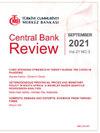Revisiting inflation inertia: A comprehensive analysis of dynamics and connectedness in the Turkish case
IF 1.2
Q2 ECONOMICS
引用次数: 0
Abstract
This paper examines the phenomenon of inflation inertia in Türkiye focusing on its persistence and the role of interconnected price-setting behaviors. Utilizing monthly data from 2004 to 2024, the study applies a novel augmented Phillips Curve framework, integrating a Time-Varying Parameter (TVP) approach with a connectedness measure derived from the Antonakakis et al. (2020) methodology. Our aim is to investigate the interplay between consumer price inflation and sub-level pricing dynamics to understand how interconnectedness amplifies inflation persistence. This study uniquely contributes to the literature by analyzing inflation inertia alongside the influence of commodity price interconnectedness, offering a dual perspective on inflation dynamics. The findings reveal a marked increase in inflation inertia in Türkiye since 2018, driven by stronger inflation expectations and intensified price interconnectedness, particularly after 2022. The results underscore the compounded impact of synchronized pricing adjustments and sectoral linkages in perpetuating inflation persistence, which hinders the effectiveness of conventional monetary policy. Robustness checks by employing Markov Switching Regression (MSR) models, the quantile-on-quantile (QQ) regression and causality results confirm these dynamics. Policy recommendations emphasize the need for a coordinated approach, integrating monetary, fiscal, exchange rate, and income policies to reduce system-wide price interconnectedness. Central banks must adopt a clear and credible policy horizon to break inflationary expectations and mitigate inertia. By addressing these systemic challenges, policymakers can enhance the efficacy of inflation-targeting frameworks, supporting sustainable price stability in the face of entrenched inflation dynamics.
重新审视通货膨胀惯性:土耳其案例的动态和连通性的综合分析
本文考察了日本通货膨胀惯性现象,重点关注其持久性和相互关联的价格设定行为的作用。利用2004年至2024年的月度数据,该研究采用了一种新的增强菲利普斯曲线框架,将时变参数(TVP)方法与源自Antonakakis et al.(2020)方法的连通性测量相结合。我们的目的是研究消费者价格通胀和次级价格动态之间的相互作用,以了解相互联系如何放大通货膨胀的持久性。本研究通过分析通货膨胀惯性以及商品价格相互关联性的影响,为通货膨胀动态提供了双重视角,从而为文献做出了独特的贡献。调查结果显示,自2018年以来,由于通胀预期增强和价格相互关联加剧,特别是在2022年之后,日本的通胀惯性显著增加。这些结果强调了同步定价调整和部门联系在使通货膨胀持续存在方面的复合影响,这妨碍了传统货币政策的有效性。采用马尔可夫切换回归(MSR)模型、分位数对分位数(QQ)回归和因果关系结果进行鲁棒性检验,证实了这些动态。政策建议强调需要采取协调一致的方法,整合货币、财政、汇率和收入政策,以减少整个系统的价格相互关联性。各国央行必须采取清晰可信的政策视野,打破通胀预期,缓解惯性。通过解决这些系统性挑战,政策制定者可以提高通胀目标框架的有效性,在面对根深蒂固的通胀动态时支持可持续的价格稳定。
本文章由计算机程序翻译,如有差异,请以英文原文为准。
求助全文
约1分钟内获得全文
求助全文

 求助内容:
求助内容: 应助结果提醒方式:
应助结果提醒方式:


